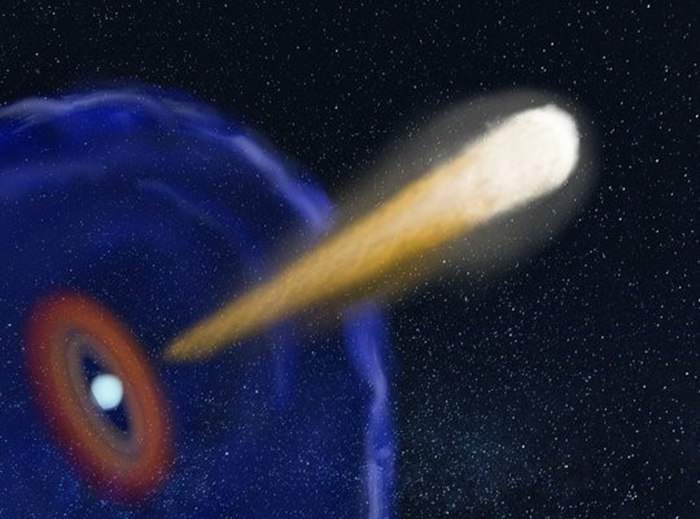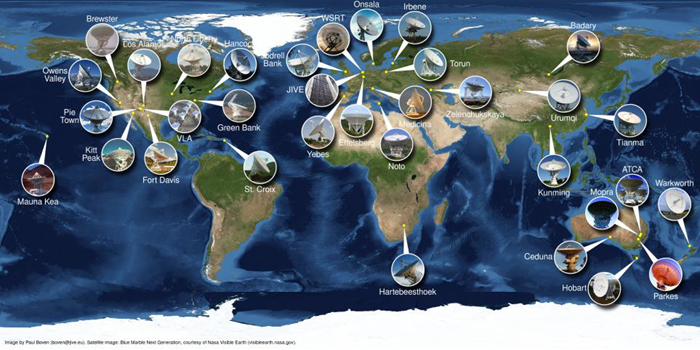Succeed or Fail? Fate of the Jet after GW170817 is Discovered
Using radio telescopes from five continents, astronomers prove the existence of a narrow stream of material (jet) emerging from the only gravitational wave event involving two neutron stars observed so far. This finding has been published in the scientific journal Science by an international team of astronomers, including researchers from the Shanghai Astronomical Observatory (SHAO).

Fig. 1: Artist’s impression of the jet of material launched after the merger of the two neutron stars. Image Courtesy: Katharina Immer (JIVE)
In August 2017, two neutron stars were observed colliding, producing gravitational waves that were detected by the American LIGO and European Virgo detectors. Astronomers observed the event and the subsequent evolution across the entire electromagnetic spectrum, from gamma-rays, X-rays to radio waves.
This neutron star merger represented the first case where it was possible to associate a detection of gravitational waves to an object emitting light. The event has confirmed scientific theories that have been under discussion for tens of years, and the association of neutron star mergers with one of the most powerful explosions in the Universe: gamma-ray bursts.
After the merger, a huge amount of material was expelled into space, forming a shell around the object. Astronomers have been tracing its evolution at different wavelengths. However, there were still some remaining questions concerning this event that could not be clarified by any previous observations.
It is expected that part of the material would be ejected through a collimated jet, but it was unclear whether this material could successfully pierce through the surrounding shell.
The fifth author, Dr. YANG Jun from University of Chalmers (also the guest professor of SHAO) said, there were two competing scenarios. In one case, the jet can not break through the shell, instead generating an expanding bubble around the object; in the other one, the jet is successful in penetrating the shell and then propagates further into the interstellar space.
Only the acquisition of very sensitive radio images with very high resolution would discard one scenario or the other. This required the use of a technique known as Very Long Baseline Interferometry (VLBI) that allows astronomers to combine radio telescopes all around the Earth to enable the highest resolution.
Another co-author, Dr. AN Tao from SHAO said, the team of this publication conducted global observations in the direction of the merger on 12 March 2018 using 32 radio telescopes including the European VLBI Network (that connects telescopes from Spain, the United Kingdom, The Netherlands, Germany, Italy, Sweden, Poland, Latvia, South Africa, Russia, and China), e-MERLIN in the UK, the Australian Long Baseline Array in Australia and New Zealand, and the Very Long Baseline Array in the USA.

Fig.2: Representation of all radio telescopes that participated in this observation. Image Courtesy: Paul Boven (JIVE).
The obtained image has a high resolution comparable to resolving a person on the surface of the Moon. In the same analogy, the expanding bubble would appear with an apparent size equivalent to a truck on the Moon, whereas a successful jet would be detected as a much more compact object.
AN Tao said, they find that only a jet could appear sufficiently compact to be compatible with the observed size, which stands for the model that the jet could break the shell successfully.
In the coming years, many more of these neutron star binary mergers will be discovered. It is expected that more than 10% of all these mergers should exhibit a successful jet. These types of observations will allow us to unveil the mystery behind these most powerful explosion events in the Universe.
Link to paper:
G. Ghirlanda, et al. 2019, Science http://science.sciencemag.org/cgi/doi/10.1126/science.aau8815
Download attachments:


